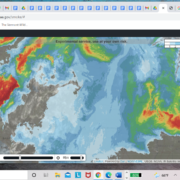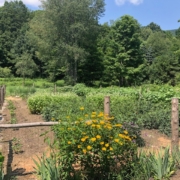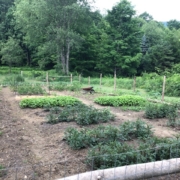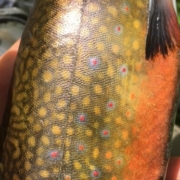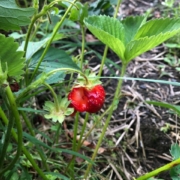Smoke Map
The skies were full of wildfire smoke today. To get a sense of where it’s coming from, check out this really cool interactive map that NOAA updates regularly.
Kind of shrinks the country, doesn’t it? And in doing so shrinks the world.
Turning a Patch of Lawn into a Vegetable Garden, Part 5
There’s an old axiom that to be a good builder you need to learn to think like a drop of water. Farming and home gardening can be similarly reduced to: you need to learn to think like a weed. There’s hundreds of years worth of cultivated plant knowledge at our fingertips, and expert growers who can tell us exactly what each garden plant wants and needs. But unless we’re growing in the controlled conditions of a greenhouse, this knowledge is partial at best. Out in the cruel, bare dirt of our short Vermont summer, the art of eliminating competition is where the garden is going to be made or broken.
We’re working on a story for Volume II about all this; talking to professionals about their tricks of the weed-killing trade. But in the meantime I thought I’d share some thoughts from my own garden this year in the hopes that they’re useful to other backyard growers who might be new to this. The plot is 1,800 square feet, and this particular garden is two years old. So far I’ve been able to keep on top of the weeds, and to quote the late Kenny Rogers, knowing when to hold ‘em and when to fold ‘em is probably the biggest reason.
I kept my cards folded all of last year. I broke ground in the spring of 2020, but then cover cropped instead of planting. This plan was based on respect for the established perennial vegetation that was being plowed under, which was going to rise again. It didn’t come to dominate that particular patch of ground by accident. This garden was built on a lawn, so crabgrass was the toughest plant of the bunch. But in a weedy meadow out back, in a different planting I did at the same time, the endemic goldenrods, milkweed, and fern all pushed back in a similar way. Patience was key. Had I tried to grow before the sod had broken down, it would have been a nightmare to fight the crabgrass. By spending a year letting the soil mellow while smothering the weed base, I was able to start the weed fight this year in a position of strength.
This year’s weed control efforts started right away, which is another piece that seems key. If I’d waited until the weeds looked like garden plants, I’d have lost the edge and it would have become real work. The truism here is that if you’ve got a weed-free garden in July, it’s because you put the time in in April and May.
Weeding the 1,800 square feet in this garden probably took a couple hours a week in June, but I’m probably down to an hour a week now that the plants have taken off. I do 20 minutes a morning on my way to the chicken house. I don’t squat unless I absolutely have to, and do 95% of the weeding standing upright with this tool.
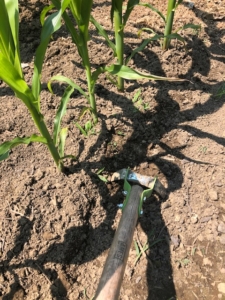
I’ve heard them called a bunch of names, including a loop hoe and a push-pull weeder. It’s basically just a two-sided blade that you can work while pushing or pulling. If you hit the crabgrass when it’s this big:
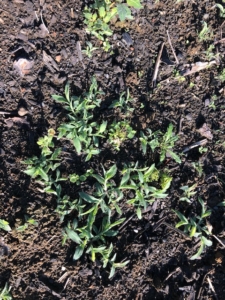
You can kill it with one hand. Those same plants, three weeks from now, would require hand digging.
As I planted, I made sure all the rows were wide enough to accommodate the tool – I use it as a cultivator, too, when the beds are just getting established. I don’t cultivate the paths that are in between the beds deeply – the paths are permanent and I don’t mind soil compaction here. When weeds grow in the paths, I run the loop hoe over lightly so they’re cut near surface level because I don’t want to dig in deeply and aerate the soil and stimulate microbial activity.
Any place in the garden that didn’t get planted this year but might someday got covered. In some beds that meant planting buckwheat or sunflowers, which grow fast and dense – they’re placeholders that bees and birds love. Other areas got covered with old newspapers and then any biomass I had lying around, like old leaves or planer shavings. The point was to eliminate bare dirt as much as possible.
The danger of these kinds of pieces is that the writer can come off as smug – it’s like the way Facebook makes everyone’s life seem more photogenic and perfect than it really is. So let me assure you, this garden has plenty of imperfections. I mulched a bed of peppers with newspaper and planer shavings in late May, and I think I set the plants back at least 2 weeks because the soil temperature couldn’t get warm enough under the mulch. I didn’t look closely at the straw I used last fall to mulch garlic, and the weed seeds in it – weeds I don’t recognize – have been a pain to deal with all summer. That was very much a self-inflicted wound. I could go on.
Still, I’m happy with how things look, and I hope there’s something helpful here for people who are new to all this.
Turning a Patch of Lawn into a Vegetable Garden, Part 4
I’m working on a piece about soil fertility for Volume II of the Almanac, and part of my background research involves reading a book the late Jack Lazor wrote on grain growing. Lazor broke soil fertility down into three interdependent realms: the chemical, the physical, and the biological. And he made the point that conventional agriculture can be exploitive and short sighted when farmers just focus on the chemical. Through Lazor’s organic lens, soil is an ecosystem where billions of microorganisms “work in conjunction with a soil’s mineral and humus factions to feed themselves and the plants that grow there.” High levels of organic matter mean happy microbes and happy plants, and so growers use compost and cover crops and manures to grow soil before they grow plants. In a conventional system, farmers just add chemical nutrients from a bag, and without mitigation measures, the organic matter in this soil is depleted.
Farmers transitioned away from organic practices for financial reasons. And in theory, us home gardeners have the luxury of being able to do better because we don’t have a profit motive. And yet it’s so hard, even for us, to escape the chemical mindset; the allure of magic in a bag as opposed to the hard work of incorporating three yards of compost with a shovel and pitchfork.
I think part of the problem here is that we’ve been conditioned to see fertilization as an act of care. We’re feeding our plants from the bag. And chemical fertilizer works. If you go out and sidedress your plants with some Scott’s 10-10-10 this week, and we get adequate rain, they’re going to pop. Lazor points out that the soil carbon is burned up in the process of converting the fertilizer to Nitrogen, and over time soil is hardened by modern fertilizer. But this is a problem years in the making, as opposed to results that are immediate and easy to see. And if one plant food takes seconds to apply, and the other hours and days, then why not push the easy button?
I think a better way to get through to home gardeners about the benefits of organic amendments is to highlight the way organic soils hold water. In my experience, water retention, not fertility, is the miracle of compost. That’s the reason to do the hard work. For every one percent increase in organic matter, an acre of soil will retain an additional 160,000 gallons of water. And as the climate changes and weather gets more extreme, home gardeners are going to be dealing with dry conditions more and more. It’s easier to get nitrogen from a bag than from compost, but it’s easier to mix in compost once a year than it is to lug a watering can around to every plant all summer.
I laid out this garden with a center hallway, then used a broadfork and hand tiller to elevate beds. (Because this was a lawn that’s been mowed for decades with a riding mower, it’s pretty heavily compacted.) I borrowed a truck trailer and bought 2.8 yards of compost, which I incorporated into the top layer of the beds. That’s all I did to make the beds. I didn’t raise them because I want the plants to be able to work their roots down into the cool reservoir of the earth. As I add compost each year, they will naturally raise themselves.
So far this year it’s been relatively dry. And I’ve done no supplemental watering. Still, the dirt’s inherent 4.6 percent organic content (this figure from the initial soil test) and the compost I added have allowed the plants to take hold and take off.
Trout Fishing
My friend Kris and I met in Mrs. Kevorkian’s kindergarten class, which means I’ve been a bad influence on him for three decades now. When I suffer from panic attacks brought on by the realization that another summer’s slipping through my fingers, I often find myself dialing his phone number. “Wrap it up,” I said on a Friday morning, “we’re blowing off work.” About an hour later we had the rods in the back of his Jeep and were pointed up a wood road, climbing into the hills.
As the jeep bumped and bucked over the washed-out macadam we puffed bug-spray cigars and told fish stories: that Boy Scout trip to a remote Vermont pond that may or may not exist anymore, where as a 10-year-old I hooked an 18-inch brookie on the day’s first cast; a sinkhole in New York’s Beaverkill river where monster browns torpedoed from the depths like sharks.
We parked near a small brook and followed a tannin-stained ribbon of water into a birch glade. You hunt trout in water like this. We stalked on tip toes to the head of each pool and made offerings without casting shadows. More often than not the cagy brook trout would scatter with the rods first motion – quicksilver shapes, there then gone – but a few hits set. When hooked these little trout danced across the surface of the water on lean, wild muscles.
Eventually we hit a chain of beaver ponds and fished them, too. Beaver pond trout fishing is ephemeral. If the water is cold enough, and the conditions are right, these ponds can be jewels. But then overnight, maybe the fishing’s gone. Maybe you get a year out of a pond, maybe two, or five. But maybe the conditions will never be right, or never be right again.
We fished three ponds that day, big expansive wetlands that lay sprawled out on a plateau that was about 2,000 feet above sea level. There was no human sound anywhere. Just the whisper of a light, steady wind. Bird song. The whipping sound of the rod as it cut through the air and the occasional click of a turning reel.
We stood on the dam and cast dry flies onto a tea-colored canvas. Fifteen feet from shore a beaver trolled back and forth, his keen black nose trying to make heads or tails of us. In the middle distance, beyond the pear-shaped contour of the pond, the wind pressed its presence into the lime green saw grass: feathered naps and cowlick whorls; look at the hair on your forearm and see the wind blow through this grass.
Rods bent and lines sheared through the tannin-stained depths. Lines sheared.
I found this old essay in a pile of papers while cleaning my office. It was written in July, 2008. Kris and I both have four-year-old daughters now, and those carefree days of being able to blow off and go fishing seem like a lifetime ago. With luck, though, and time invested in passing on our passions, the girls will someday be blowing off work together to find the same ponds we did.
Eyes Wide Open
The idea that chickens and gardens are symbiotic is more than half bunk. They do eat bugs, but both good bugs and bad bugs. If your ratio of bad to good is such that you’re willing to play the odds, consider that they don’t eat many bad bugs when they have a belly full of layer pellets. And if they are hungry, which would be the way to get them to eat your potato beetle larvae, then they’re also going to be hungry for your garden plants. They like the same foods we do, and seem to especially like the same foods we especially like, like berries and heirloom tomatoes. They do cultivate and drip nitrogen, but they’re also destructive. If someone showed up at your doorstep and offered to sell you a bunch of tiny tractors driven by mentally-deficient drivers to turn loose in your summer perennial garden so they could randomly cultivate and spread manure you’d tell them to take their crazy idea and get off your lawn. But we’re suckers for the allure of a good complimentary system – especially natural ones. So it’s easy to put aside our logical minds and convince ourselves that our freeranging chickens must be benefiting us somehow.
To be clear, there are advantages to freeranging your backyard flock. You don’t have to build a run. You get the satisfaction of letting the little dinosaurs live their best lives. You probably save some money on chicken food bills – actually, strike that last one, since the inevitable mortality you’ll eventually suffer will cancel out any food-bill gains over the long haul. So there are two advantages. The point, if you’re considering chickens, is not to suggest you shouldn’t let them freerange. Just don’t get deluded into thinking they’re little garden helpers.

